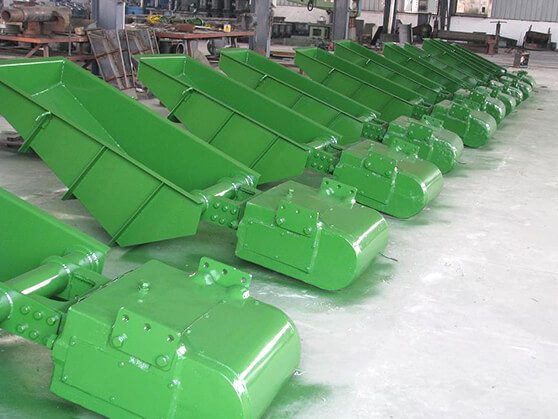In the bustling heart of modern industry, where efficiency, reliability, and precise material handling are paramount, a seemingly simple device plays a critical role: the Alimentador vibrante electromagnético. This robust and versatile piece of equipment silently powers countless assembly lines, processing plants, and packaging operations, moving everything from delicate pharmaceuticals to rugged mining ore with remarkable control and consistency. Understanding its operation, advantages, and applications is key to appreciating its widespread adoption. This article delves into the core principles, benefits, and uses of this indispensable industrial workhorse.
Demystifying the Core: How an Electromagnetic Vibration Feeder Works
Unlike feeders driven by rotating motors or pneumatic systems, the Alimentador vibrante electromagnético harnesses the controlled power of electromagnetism. Its operation is elegant in its simplicity:
The Core Components: At its heart lie two primary components:
- Electromagnet Assembly: This is a coil of wire wound around a magnetic core. When electrical current passes through the coil, it generates a strong, rapidly pulsating electromagnetic field.
- Vibrating Tray (Pan): This is the inclined, spring-mounted trough or platform that physically carries the material. It’s typically constructed from robust stainless steel or other wear-resistant alloys.
- Spring System: Connecting the vibrating tray to the base frame is a carefully tuned system of leaf springs or coil springs. These springs are crucial, acting not just as supports, but as energy storage and release mechanisms.
The Physics of Motion: Resonance and Controlled Chaos: The magic happens when alternating current (AC), often half-wave rectified AC, flows through the electromagnet coil. This creates a rapidly cycling magnetic field.
- Attraction: During the “on” half-cycle of the rectified wave (when voltage is positive), the energized electromagnet powerfully attracts the armature plate attached directly beneath the vibrating tray.
- Release & Recoil: As the current drops to zero (the “off” half-cycle), the magnetic field collapses, allowing the tray, propelled by the stored energy in the stretched springs, to snap back to its original position.
- The Resulting Movement: This rapid, cyclic sequence of attraction and release generates a high-frequency, low-amplitude linear or elliptical vibration in the tray. The material resting on the tray reacts to this vibration through micro-throws. Friction against the tray surface is momentarily overcome during the forward stroke, propelling the material up the slight incline of the pan. Gravity then pulls the particles back down onto the pan during the recoil stroke, ready for the next cycle. The net effect is a controlled, directional flow of material.
Tuning for Performance: En Alimentador vibrante electromagnético system is typically designed to operate near its resonant frequency. This significantly amplifies the vibratory effect while minimizing the electrical power required. The stiffness of the springs and the mass of the moving parts (tray + material) determine this natural frequency.
The Compelling Advantages of Electromagnetic Drive
Why choose an Alimentador vibrante electromagnético over other feeding technologies? The answer lies in its unique set of advantages:
- Exceptional Precision and Control: This is arguably its greatest strength. By simply varying the input voltage to the electromagnet (using a simple variable transformer or sophisticated controller), operators gain precise, instantaneous control over the vibration amplitude. Increase the voltage = increase amplitude = increase material flow rate. Decrease voltage = decrease flow rate. This allows for incredibly fine metering of even minute quantities of material. Flow rates can be easily adjusted from zero to maximum without needing to physically change components.
- Instantaneous Start/Stop: When power is cut, the vibration ceases almost immediately because there is no rotating inertia to overcome, unlike motor-driven feeders. This allows for highly responsive starting and stopping, crucial for synchronized feeding or precise batch operations.
- Simplicity and Low Maintenance: Fewer moving parts compared to mechanical eccentric drives translate directly to higher reliability and lower maintenance needs. There are no gears, motors, or complex linkages to lubricate or wear out. Primarily, maintenance involves checking spring integrity and the armature gap.
- Eficiencia energética: Operating near resonance minimizes the electrical power required to generate effective vibrations. Lower energy consumption translates into reduced operating costs.
- Gentle Material Handling: The high-frequency, low-amplitude vibration generated by an Alimentador vibrante electromagnético is exceptionally well-suited for fragile or friable materials (like snack foods, pharmaceutical tablets, or flaked graphite) that might be damaged by impact or tumbling found in screw feeders or belt feeders.
- Clean and Enclosed Operation: The feeder’s construction allows for easy integration into sealed housings or clean environments (like food or pharmaceutical lines). Material is contained within the tray, minimizing dust generation and spillage, and surfaces are readily cleanable.
- Handling Diverse Materials: With appropriate tray designs (liners, coatings, shapes), these feeders can handle a vast range: powders, granules, flakes, pellets, small parts, and even abrasive materials.
Where Electromagnetic Vibration Feeders Shine: Key Applications
The precision, control, and versatility of the Alimentador vibrante electromagnético make it indispensable across numerous sectors:
- Embalaje: Accurately feeding precise counts of tablets, capsules, candies, nuts, hardware (screws, nuts, washers), and other small items into blister packs, bottles, boxes, or bags.
- Procesado de alimentos: Handling delicate food items (chips, cereals, frozen vegetables, coffee beans) without breakage. Metering ingredients, sorting, and conveying within processing lines.
- Pharmaceutical: Precisely dosing powders, granules, and tablets for encapsulation, pressing, or liquid filling under strict hygiene requirements. Feeder systems often require full washdown capability (IP69K).
- Chemical & Plastics: Metering powders, pigments, pellets, and additives into mixers, reactors, or extruders with high accuracy.
- Automation & Assembly: Orienting and feeding intricate components (springs, pins, electronic chips, bearings) reliably to robots or assembly stations for automated manufacturing.
- Mining & Minerals: Controlled feeding of bulk materials like ores, aggregates, or sand into crushers, screens, or weighing hoppers, even in harsh environments (often utilizing heavier-duty designs).
- Powder & Bulk Solids: Metering free-flowing to semi-cohesive powders for filling, batching, or blending operations.
- Recycling: Sorting and feeding scrap materials based on vibration response and trajectory.
Choosing the Right System: Key Considerations
Selecting the optimal Alimentador vibrante electromagnético involves evaluating several factors:
- Características del material: Particle size, shape, density, flowability, abrasiveness, and moisture content directly influence tray design, vibration amplitude needs, and potential liners/coatings.
- Required Feed Rate (Capacity): Must match the peak demand of the downstream process.
- Control Precision: How fine does flow rate adjustment need to be? Does it need to respond dynamically to signals from a PLC or weighing system?
- Operating Environment: Cleanroom, food grade (stainless steel), washdown (IP69K), hazardous area (ATEX/IECEx), high temperature? Material of construction (tray, base) is critical.
- Tray Design: Size, shape, depth, inclination, and presence of features (tooling, baffles) tailored to handle the specific material effectively (e.g., shallow for parts orientation, deep for powders).
- Base Mounting: Requires a rigid, level base to function correctly without energy loss. Isolation mounts are often used to prevent vibration transmission to surrounding structures.
- Controller Type: Simple variable transformers (Variact®) for basic control, SCR controllers for finer adjustment, or sophisticated microprocessor-based units enabling ramping, batching, and communication protocols.
Maintenance Essentials
While inherently low-maintenance, ensuring longevity requires:
- Regular Armature Gap Inspection: The air gap between the electromagnet core and the armature plate is critical. It must be kept consistent and adjusted as per manufacturer specs if wear occurs.
- Spring Integrity: Periodically inspect leaf or coil springs for cracks, fatigue, or significant deformation.
- Tight Fasteners: Vibration can loosen bolts; regular checks and tightening are necessary.
- Tray Wear Inspection: Check the tray surface, particularly with abrasive materials, for excessive wear that could affect performance.
- Limpieza: Keeping the unit free of material buildup, dust, and moisture prevents issues.

Electromagnetic vs. Mechanical Vibratory Feeders
It’s common to compare Electromagnetic Vibration Feeders with mechanical vibratory feeders (driven by unbalanced motors/rotating eccentric weights). Key differences:
- Control: Electromagnetic wins for precise, variable flow control.
- Start/Stop: Electromagnetic offers instant stops/starts; mechanical feeders have coast-down time.
- Mantenimiento: Electromagnetic generally has fewer moving parts and lower maintenance.
- Eficiencia energética: Electromagnetic is often more energy-efficient due to resonant operation.
- High Capacity/Heavy Duty: Mechanical feeders can sometimes handle higher capacities or heavier, denser materials more economically at large scales.
- Stroke: Electromagnetic produces a smaller amplitude stroke at higher frequency; mechanical often has a larger, lower-frequency stroke.
Conclusión
En Alimentador vibrante electromagnético stands as a testament to elegant engineering solving complex industrial challenges. Its core principle – leveraging controlled electromagnetic pulses to generate precise vibratory motion – delivers unparalleled accuracy, responsiveness, and material-handling versatility. From safeguarding delicate pharmaceuticals to ensuring snack foods arrive intact in your bag, or precisely placing components on a circuit board at lightning speed, this technology is foundational. Its advantages in precision control, low maintenance, energy efficiency, and gentle handling make it the preferred choice wherever consistent, reliable, and adjustable feeding or conveying of bulk solids or small components is required. Understanding its workings and applications empowers industries to optimize their processes, enhance product quality, and achieve greater efficiency in an increasingly demanding world.

